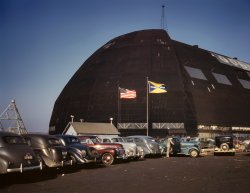
MAY CONTAIN NUTS

Search Shorpy
SHORPY ART

Framed or unframed, desk size to sofa size, printed by us in Arizona and Alabama since 2007. Explore now.
Join and Share
Ad-Free Shorpy
Shorpy is funded by you. Patreon contributors get an ad-free experience.
Learn more.

Recent comments
- Lost in Toyland
- And without gloves
- If I were a blindfolded time traveler
- Smoke Consumer Also Cooks
- Oh that stove!
- Possibly still there?
- What?!?
- $100 Reward
- Freeze Frame
- Texas Flyer wanted
- Just a Year Too Soon
- WWII -- Replacing men with women at the railroad crossing.
- Yes, Icing
- You kids drive me nuts!
- NOT An Easy Job
- I wonder
- Just add window boxes
- Icing Platform?
- Indiana Harbor Belt abides
- Freezing haze
- Corrections (for those who care)
- C&NW at Nelson
- Fallen Flags
- A dangerous job made worse
- Water Stop
- Passenger trains have right of way over freights?
- Coal
- Never ceases to amaze me.
- Still chuggin' (in model form)
- Great shot
Member Photos
The Shorpy
Print Emporium
Print Emporium
Search Shorpy
Search results -- 30 results per page
- Old Reliable: 1942
- ... dependable mechanism." 4x5 Kodachrome transparency by Alfred Palmer for the Office of War Information. View full size.
Garand Rifle ... Posted by Dave - 02/15/2019 - 3:55pm -
![Old Reliable: 1942 June 1942. Fort Knox, Kentucky. "Infantryman with halftrack. A young soldier sights his Garand rifle like an old-timer. He likes the piece for its fine firing qualities and its rugged, dependable mechanism." 4x5 Kodachrome transparency by Alfred Palmer for the Office of War Information. View full size.
Garand RifleInteresting photo. Latest rifle, the Garand and a World War I type helmet. Looking at the markings on the vehicle, it doesn't seem to be US ARMY. Could it be US MARINE CORPS?
[U.S.A.W. - Dave]
HelmetIf I remember correctly, the US used those WWI/British style helmets until early 1942, when it switched to the more familiar "wrap around" helmet used through the rest of the war. I suppose the old helmets could still be used for training.
Helmet TransitionI have photos of my father in the Army in 1941 and 1942. In the early photos, in training in Alabama, he is wearing one of the doughboy style helmets. After the war started, there are photos of him in Hawaii in 1942 with the newer, more familiar GI style helmet.
Tire's on backwardThe directional tread on that tire's going the wrong way, so either the tire was put on the rim wrong or the right and left wheels were switched. The factory shots have them mounted correctly.
[I bet they knew what they were doing. See above. - Dave]
Tires on backwardIf it was a drive wheel it is definitly on backwards. A drive tire put on this way would not be self cleaning. It would fill up with mud and lose traction. Put on correctly the tire will be self cleaning and retain traction. With non-drive tires the direction of the tread is irrevelant.
["Irrevelant"? See above. - Dave]
The tire is on backwardFarm kids pick this stuff up early, with chevron-type tread like that on a powered wheel the bars won't self clean and the tire is effectively bald in mud or snow. This is the recommended mounting for a non-powered wheel, unfortunately it's on a driven axle. The government was in the process of changing to the more familiar NDT (Non Directional Tread) right about the time this picture was taken, it simplified maintainance and eliminated possible future issues like this halftrack might experience.
[If only you'd been there to tell them. And them and them and them. - Dave]
Leave it to ShorpyLeave it to Shorpy commentors to start a tire tread direction thread. Surprised me to realize I've never thought about it before, and I'm an old guy.
It would seem having the tread chevron point first as it contact a dry surface would provide a modicum of extra grabbing force. Although, as the below people noted, it would be gunked up immediately in mud and snow.
It's hard to imagine they'd stop and turn their treads every time the weather changed. Just choose one and live with it. So, it's easy to see where mult-directional treads would take care of having to make a call on the old treads and their direction. Solving problems, one of man's more useful abilities.
Can't believe I just wrote three short paragraphs on tire tread direction on large vehicles of long past decades. Maybe that's why I love this site. Brings out some unique discussions and responses at times.
Tire Treads"This is the recommended mounting for a non-powered wheel, unfortunately it's on a driven axle."
I was not aware that the front axle on a half-track was a driven axle. In fact I don't think it was - the front wheels were for steering while the tracks provided power. You will observe on the photo of the truck (the middle of the three that Dave posted) the front tires was chevrons forward and the rear tires were chevrons back.
[As we can see from the axles and differential cases in the photos already posted, the front wheels are driven. - Dave]
Stuck in the MudWhile I shouldn't try to second guess the military thinking of the day regarding which way to mount their front tires, I can report why we would occasionally run farm tires "backward".
The idea in mounting R-1 (chevron) tires backward was that you had better traction going in reverse than forward. Thus, with superior traction in reverse, you could (almost) always count on being able to back out after you got stuck. Yes, it also meant you were more likely to get stuck in the first place but the chances you'd have to call for a tow in that event were supposedly less likely.
While you wouldn't likely see this done on a tractor, it was fairly common to see it on combines. Especially in areas known for a wet harvest like Oklahoma wheat harvest or soybean harvest in Mississippi.
The other possibility for running their front tires backward might have had something do with wear issues. Chevron tires wear out quickly on pavement when run the "right" way. As I recall, the leading edge of the outside tread bar will wear away fast. By running the tires backwards, they may have found the tire treads wore down more evenly and lasted longer.
Well, just a thought anyway.
[Note that the WW2 tire and the R-1 tractor tread (below) are totally different designs. In the R-1 the tread is made of separate ridges. Which is what gives you traction and self-cleaning at the same time. You could put it on either way and get dig-in, either from the middle or from the edges. On the WW2 tire the ridges are all connected at the middle. The only dig-in is from the edges. - Dave]
RotationYou guys are amazing. Good point about not trying to second-guess military thinking on these matters--no doubt they did have their reasons. One might simply have been that the front wheels on halftracks run on paved roads would certainly wear unevenly, and with no back wheels to add to the mix the only way to rotate them is to run them with the treads going the other way for a while. Perhaps they were more likely to do this in conditions where dig-in was less of an issue, or when the front wheels were being used unpowered (though I don't know whether that was an option, as it was on my old Power Wagon). At least in training or other less time-critical situations, they could still switch them back before conditions were likely to get muddy. I'll bet there was a manual on this at one time.
This is speculation, but I'm wondering if the central tread ridge connection on the WW2 tires was perhaps designed to improve wear on pavement, since it puts a more or less continuous band of rubber on the part of the tire with the most road contact. I would think it might also help the tire retain its shape as it compresses on contact, which could also improve wear on pavement.
Related question: I've often wondered whether the powerful rear tracks on halftracks could sometimes overpower the steering capabilities of the front wheels in certain particularly loose conditions, especially since I understand most of the load is over those tracks. Thus the wisdom of driven front wheels--but I'm wondering if there was also an option to brake a rear track individually, as with a tank. I would think steering like that from both the front and rear would be the ultimate combination.
Historical tiresLow pressure, pneumatic farm tires first appeared only 10 years before this photo was taken. Not long before the war, new tractor production had finally just made the switch over to majority rubber tires in place of steel wheels.
The first farm tires evolved from knobby aircraft tires into the 45 degree barred tires still common today. Many of the early barred farm tires had a tread connector strip down the center of the tire similar to the tires on your halftrack.
I don't know when the tread codes (R, F, I) first appeared but my guess is not until the 50s or 60s. Your halftrack tires are probably closer to what is today an R-4 tread rather than an R-1. The R-4 is directional and similar to the R-1 but has less open area.
At low speeds (under 12mph), the barred tire self-cleaning action comes as mud is forced from the center of the tire to the outside. Squished. Trust me, if you reverse a directional barred tire, this self-cleaning mechanism disappears quickly. The tires ball up with mud and won't self-clean run backwards until you get enough speed up (25mph+) to "throw" the mud off.
"Reid Gray" may have hit on your answer though. The tires may have also been run backwards to keep them clean and maintain front traction for steering. That makes more sense than anything I mentioned.
Keep up the good work. Thanks.
M1 Garand RifleThe soldier in both the photo taken in June 1942 by A Palmer of the OWI, and this one, are members of the US Army. Both are wearing the M1937 helmet and their M1 Garands are the very early "gas trap" model. This system was was discontinued in July 1940 in favor of the "gas port" model which continued in use until production was finally discontinued in 1957 in favor of the M14 Rifle.
Both soldiers are wearing the obsolete helmet and using the obsolete rifle because they are probably participating in training field exercises. I suspect both photos were taken by Mr. Palmer, probably on the same day in June 1942 as it appears that the markings on the bumper indicate that it is the same half track.
M1 GarandThe Garand shown is in color photo is a Gas Port design and not the earlier Gas Trap design. http://www.fulton-armory.com/GasTrapGallery.htm
It's a gas port all rightAgree, that's a gas port rifle. Gas trap rifles were in use as well, although they were to be refitted with the newer design parts when they were sent back for depot maintenance or overhaul. Note the early sight knob without the lock bar.
Only the Army had M1 Garands at this point. The Marines stuck to their trusty 1903 Springfield rifles until first-hand experience alongside the Army at Guadalcanal convinced them that the new design was preferable.
Note the mix of WW1 gear (belt, canteen and other gear), interwar helmet (WW1 metal, 1934-era liner) and new rifle and herringbone twill uniform. This was common then, and I admired the movie "The Thin Red Line" for getting that right.
Bumper #The "D-R" stands for demonstration Regiment.
(The Gallery, Kodachromes, Alfred Palmer, Cars, Trucks, Buses, WW2)](https://www.shorpy.com/files/images/1a35211u.thumbnail.jpg)
- Wingwomen: 1942
- ... View full size. 4x5 Kodachrome transparency by Alfred Palmer.
They remind me of They remind me of Laverne and Shirley
... Posted by Dave - 08/10/2012 - 3:46pm -
![Wingwomen: 1942 October 1942. North American Aviation workers assembling wing component for a P-51 fighter. View full size. 4x5 Kodachrome transparency by Alfred Palmer.
They remind me ofThey remind me of Laverne and Shirley
[Wonder if I have any Kodachromes of the Blatz bottling plant ... - Dave]
women at warSeeing this picture reminded me of how proud I am of my mother. She worked at the Watervliet Arsenal (NY) during the war. Thanks for the memory.
Reese Witherspoon's MomI guess that's what I saw. She's cute
Made my ex jealousI have this as my desktop right now.
My ex-wife came over to pick up our son and almost the first thing out of her mouth when she came in the door was 'Who are THEY?'
I think it was the first time she didn't ask 'where do you find this crap?' I guess jealousy is an improvement.
[We here at Shorpy do what we can. Thanks for sharing! - Dave]
ArsenalI lived for a while on the other side of the fence from the Arsenal. It humbled me to think of all the amazing things that went on inside. I'm more so touched now to think of your mother.
Excellent attention to detailComposition and lighting show great care. Note how the lighting makes the subjects stand out from a potentially cluttered background.
Despite bright lighting, the facial features are not obscured by reflections on the protective masks. Did photographer Alfred Palmer employ a polarizing filter to screen out reflections, or were they removed in post-processing with Photoshop? Maybe both.
As with many images in this series, the women appear to be dressed and groomed for the photo op--a natural reaction.
(The Gallery, Kodachromes, Alfred Palmer, Aviation, WW2)](https://www.shorpy.com/files/images/1a35298u.thumbnail.jpg)
- Roger the Riveter: 1942
- ... in Long Beach, California." Kodachrome transparency by Alfred Palmer. View full size.
Outta Time "Roger" looks very 1965, like ... Posted by Dave - 06/19/2017 - 2:31pm -
![Roger the Riveter: 1942 October 1942. "Riveter at work at the Douglas Aircraft plant in Long Beach, California." Kodachrome transparency by Alfred Palmer. View full size.
Outta Time"Roger" looks very 1965, like he's gonna be hitting the surf as soon as work's done.
Thought it had to be a trainer ...Until I took a closer look at the "wooden" wing ribs and saw that despite their color they are aluminum. At first glance they looked to be made of solid birch, which would make the plane a trainer or, at its most ferocious, a light observation or liaison aircraft.
Across the pond, the Spitfire was supposedly based heavily on wooden members in its construction, though to what degree I cannot hazard a guess. And then there's America's Spruce Goose, genuinely unique and an anomaly almost before construction began. But I don't believe any first-line fighters or bombers in the US inventory during World War II had wooden structural members.
Always open to having my misconceptions corrected, of course.
Airplane?I'm a little at a loss what airplane this would be for.
The wing shape is for a low speed airplane, and it's awfully small, and not tapered in chord; and there are no attachment points at the root.
Not bucking for a promotionThis appears to be a staged photo, as he's not standing up, holding a bucking bar on the inside, and I don't see another worker holding a bucking bar. The rivets he's driving are AN426 (the AN stood for Army/Navy) 100 degree countersunk aluminum rivets. Today they're designated MS20426, the MS standing for Mil-Spec. I got to drive and buck both these and the round head AN470 (later MS20470) rivets, in high school in the '70s.
The countersunk rivets required a special countersinking bit, or, in some cases (small parts), the metal was stamped to the required 100 degrees.
[To quote Dave: [As we have pointed out elsewhere, most of the Palmer photos were posed. Some were used as studies by illustrators painting recruitment and bond drive posters. - Dave] -tterrace]
(The Gallery, Kodachromes, Alfred Palmer, Aviation, WW2)](https://www.shorpy.com/files/images/SHORPY-1a35353u2.thumbnail.jpg)
- We Met at Work: 1942
- ... View full size. 4x5 Kodachrome transparency by Alfred Palmer for the Office of War Information. Happy Valentine's Day from Shorpy!
... Posted by Dave - 03/19/2016 - 10:02am -
![We Met at Work: 1942 October 1942. "Riveting team working on the cockpit shell of a C-47 transport at Douglas Aircraft Company, Long Beach, Calif. The versatile C-47 performs many important tasks for the Army. It ferries men and cargo across the oceans and mountains, tows gliders and brings paratroopers and their equipment to scenes of action." View full size. 4x5 Kodachrome transparency by Alfred Palmer for the Office of War Information. Happy Valentine's Day from Shorpy!
The planeThe plane in question is the cockpit windscreen of a C-47 transport, the plane that dropped paratroopers into Normandy in advance of D-Day.
[Indeed it is. A second photo of the riveter (see above) correctly identifies the plane. I fixed the caption, thanks. - Dave]
This picture is fake.Erm ... you might want to point out that this photo is
a) not vintage
b) staged
c) very much modern
d) not any of the things you say it is.
For example, the film is wrong. She's wearing purple socks. That dude would be IN THE WAR. Her rivet gun isn't attached to anything, and is the wrong make and model, not to mention about twenty years beyond the correct kind. That's not the cockpit of a B-25. her shoes are wrong. his pants are wrong. that's not how airplanes are made.
Come on. Seriously. It's a decent picture, but to claim that this is 'vintage' is utter bullshit.
------------------------------------------------------------
[A not unusual comment from people who are
a) new to the site
b) ignorant of the history of photography
c) possibly ignorant in general.
(There is a (d) but this is after all a family newspaper.)
Alfred Palmer's large-format Kodachromes for the Office of War Information weren't "staged," they were posed, as studies for recruitment posters, exhibits, etc. It is one of many hundreds in the Library of Congress FSA/OWI archive. As for the riveter on the right, there were of course thousands of young men engaged in factory work during WW2 who were deferred from military draft because they were doing essential war work. And the woman's rivet gun is indeed attached (see below). As for the the plane not being a B-25, the commenter was right about that. It's a C-47. - Dave]
InterestingI've always been amused to see that the ladies in most of these pictures have quite obviously reapplied their lipstick for the camera. This one did not - and it sort of makes me wonder and giggle a little. Did she not want to be seen doing so in front of her male colleague?
Wannabe photo expertThat's Kodachrome for you. A youngster that thinks he knows everything simply cannot accept film reproduction this accurate, that long ago. Clearly this person has just stumbled upon a site he knows nothing about.
Also, his accusations are ludicrous given what David Hall does for a living "off-line," where personal credibility must exist before anything said or written can be believed.
Very funny post, that.
Foy Blackmon
Interesting ReasoningAs a mere dabbler in the study of history, I was previously unaware that:
- Purple socks had either not yet been invented, or were banned from civilian use for some obscure wartime purpose
- The war resulted in the complete absence of all males from the industrial workforce.
Thank you, anonymous scholar, for your insights!
Those kids think they are smarter than us...>>That dude would be IN THE WAR.
That dude might had flat feet or tunnel vision. There were several men classified unfit for the duty, they didn't go home and cry about it. They went to contribute the war effort by working in the factories.
Amusing AssumptionHa! That assumption made a few posts ago is actually pretty funny. It reminded me of a Calvin & Hobbes comic from several year ago in which Calvin is looking at some old family photographs. He asks his father why the old photos are all black and white and only the newer pictures are in color. His put-upon father, acting as my own father did on occasion, explained to him that back then, color hadn't been invented yet. Not just color film, but actual color. Sky, grass, hair, skin and clothing only existed in various shades of gray so that's how it showed up in old photos, movies and TV shows. I'm sure Calvin's mom eventually straightened them both out.
As incredible as digital photography is, it's not really as big an improvement as it's been made out to be. Mainly it's just faster, and that's all that seems to matter much anymore. Working with film had a learning curve, you had to study what you were doing and over time you developed a skill that you didn't previously possess. Well geez...who's got time to screw with that anymore. You can just take a shotgun approach to photography now and if things still don't look right you can pump it up with editing software.
So when a beautifully lit, sharply focused, highly detailed, well composed, color saturated photo is seen now some people are going to assume that it had to have been taken recently and digitally manipulated. Because it looks so much better than the pictures they're taking with their cell phones.
Look at a zoomed in crop of the woman's ear in this picture. You can tell that the back lighting is actually passing through her ear. Her ear isn't just reflecting light, it's glowing. Many modern cameras are capable of recording this kind of subtlety and detail as well, but this photo says so much more about the photographer than the type of camera or film he used. That's not to say that these guys didn't have their own bag of tricks for developing and printing their photos that made them even more eye catching, but they didn't tend to be pasted together from the best parts of two or three individual shots.
One of the joys..of coming to this site, beyond the fantastic pictures, are the intelligent comments that often reveal even more about the subject. It is just as enjoyable to see comments that do exactly the opposite, and the ease with which the audience can put them in their place.
Beautiful picture, BTW. My great aunt was a "Rosie" and I have a whole photo album of her and her 'girlfriends' whooping it up in their off-time in exotic Wichita, KS (well, exotic when you've come from Sapulpa, OK, I guess).
Re: Not how airplanes are made.Yes it was, and still is.
Look up "bucking bar".
You'd be surprised how hand-built even the most complex airliners are.
Mom Bucked RivetsMy mother got her start at Boeing in the 1960's bucking rivets just as depicted in the photo. Only it was her holding the bucking bar, and the guy held the riveter.
This picture is a fake?Blame it on digital photography. Kids today are so used to digital photography, they have no idea as to the quality of film. As a professional photographer, digital doesn't come close. Most people today only use digital because it's faster, cheaper and uses less light. Digital is based on the amount and quality of the mega pixels, the size of the sensor and the size/quality of the lens. Film has many more variants; in the film alone the size, grain, speed all make a difference. Not to mention the camera, lens, etc. And the other submitter's right about the light and the ear, there's a big difference in the way film and digital captures light. Lastly, bobby sox were popular in many different colors (including purple) during the war, my mom had a drawer full.
Pomposity deflatedThis series of posts perfectly displays one way the site is so edifying and entertaining. Dave posted a beautiful, educational photograph, made an educated guess at the background and then graciously accepted a correction to a detail. He and others, in scholarly, civil fashion then made mincemeat out of a pompous nincompoop. Made. My. Day.
[As for me making a guess at the background, I just copied the LOC caption info. Which turned out to be wrong about what kind of plane this is. - Dave]
How planes are made Yes this is how it is done still. It might surprise anyone who does not work in manufacturing how labor intensive building airplanes or most anything still is. Yes we have come a long way but there is no substitute for the human touch.
KodachromeI realize I am 8 years late to the party here, but one big thing in favor of a "historic" interpretation of this photo is how the reds just "pop" at you. You'll see it in any National Geographic from the early 1960s or before--back into the 1940s--or any color film of that period as well.
I bet there's a digital camera filter to get that effect, too (boy that would be fun), but it's a nice little "tell".
(The Gallery, Kodachromes, Alfred Palmer, Aviation, WW2)](https://www.shorpy.com/files/images/1a35284u.thumbnail.jpg)
- Condition Red: 1941
- ... Corp., Akron, Ohio." 4x5 Kodachrome transparency by Alfred Palmer, OWI. View full size.
Beer Barrel Polka Oh, I don't want her ... Posted by Dave - 07/17/2012 - 10:39pm -
![Condition Red: 1941 December 1941. "Electronics technician, Goodyear Aircraft Corp., Akron, Ohio." 4x5 Kodachrome transparency by Alfred Palmer, OWI. View full size.
Beer Barrel PolkaOh, I don't want her you can have her she's too fat for me!
Looks like this Goodyear worker is wearing a LOCKHEED I.D. badge. What's up with that?
Date Night?Maybe she was going out after her factory shift.
Stuffed shirtNo, I meant pressed shirt. A brand new one for the photo! And no color coding on the wires? That would make for some difficult fault tracing. If she has a date tonight, she needs to fix her nails and get some Visine in those bloodshot eyes.
Good jobLooks like the numbers on the wiring match up with the schematic.
Aircraft wiringAircraft wiring isn't color-coded, even in this day and age. In larger and more complex planes the wires have numbers printed on them every foot, but in small planes they're just white or pale tan.
DefinitelyA Lockheed ID Badge and button below that.
Goodyear, Akron, Ohio assembled the Vaught Corsair FG-XX version(s) during WWII.
Goodyear was probably just primarily an assembler of parts made by other companies with the tools and technology for the job. A search for “Corsair Subcontractors” turned up a reference to a center wing section made by Willys-Overland( a car company), Toledo, Ohio.
If the contract(s) were large enough, Lockheed probably set up shop in a Goodyear plant in Akron for Goodyear and other assemblers of the Corsair.
Yes, she dressed for the photo.
[The smaller button is a union badge for Aeronautical Lodge 727. -Dave]
ColorlessWhen I started my engineering career, I was told rather bluntly to "knock that s**t off" when I turned in an assembly drawing specifying color-coded wires. Numbers are the way to go. It seems you never know when you're going to have to rely on a color-blind assembler or repairman.
In light of that experience, I have no idea why my Chrysler has color-coded wiring harnesses.
Color BlindI remember when I was in tech school, our automotive electronics instructor was color blind. He made us use fluorescent highlighters to trace the colored wires out on the schematic so he could check our work! Talk about the blind leading the blind!
(The Gallery, Kodachromes, Alfred Palmer, Aviation, WW2)](https://www.shorpy.com/files/images/SHORPY_1a35065u.thumbnail.jpg)
- The Red Socks: 1942
- ... View full size. 4x5 Kodachrome transparency by Alfred Palmer for the Office of War Information.
Numbers That woman is ... Posted by Dave - 08/03/2012 - 10:44pm -
![The Red Socks: 1942 October 1942. Yet another still from the Technicolor pajama party that was the American aircraft industry in World War II: "Women at work on bomber, Douglas Aircraft Company, Long Beach, California." View full size. 4x5 Kodachrome transparency by Alfred Palmer for the Office of War Information.
NumbersThat woman is gorgeous! Anyone have any idea what the numbers on their pins signify?
[Employee ID tags. - Dave]
BaggiesIt appears that incredibly wide-legged jeans have been here before! Iimagine that the numbers were some kind of employee ID?
Douglas AircraftNo. 12 is the department; the others are employee number.
(The Gallery, Kodachromes, Alfred Palmer, Aviation, WW2)](https://www.shorpy.com/files/images/1a35341u.thumbnail.jpg)
- Test Pilot: 1942
- ... Calif. View full size. 4x5 Kodachrome transparency by Alfred Palmer.
Looks I can't believe that no one has commented on this man's ... Posted by Dave - 07/17/2012 - 10:10pm -
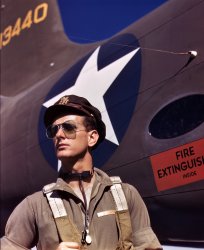
- Big Steel: 1941
- ... mills." View full size. 4x5 Kodachrome transparency by Alfred Palmer.
My Hometown These were gone by the time I was born in 1961. My ... Posted by Dave - 08/03/2012 - 10:34pm -
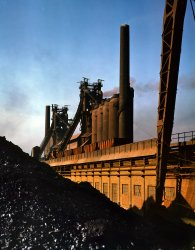
- B-25 Final Assembly
- ... works, Inglewood, Calif." Kodachrome transparency by Alfred Palmer. View full size.
Tokyo Bombed April 18, 1942 by B25's ... months after Pearl Harbor!
(The Gallery, Kodachromes, Alfred Palmer, Aviation, Factories, WW2) ... Posted by Dave - 08/03/2012 - 11:01pm -
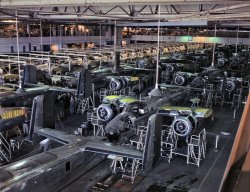
- Angel Wing: 1943
- ... View full size. 4x5 Kodachrome transparency by Alfred Palmer for the Office of War Information.
These beautiful Kodachrome ... Posted by Dave - 08/30/2012 - 2:02pm -
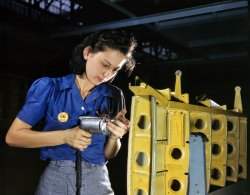
- M-3s in Action: 1942
- ... View full size. 4x5 Kodachrome transparency by Alfred Palmer for the Office of War Information.
Bogie's Tank This is the ... Posted by Dave - 08/10/2012 - 8:37pm -
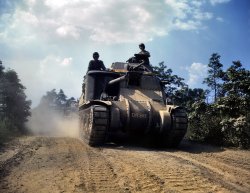
- Plane Jane: 1942
- ... View full size. 4x5 Kodachrome transparency by Alfred Palmer for the Office of War Information.
Looks like... a Flash Gordon ... Posted by Dave - 08/03/2012 - 3:21pm -
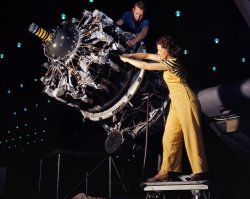
- Arsenal of Democracy: 1941
- ... are used. Note overhead cranes for heavy parts." Photo by Alfred Palmer for the Office for Emergency Management. View full size.
Book ... Posted by Dave - 11/16/2020 - 4:55pm -
![Arsenal of Democracy: 1941 August 1941. Warren, Michigan. "Tank manufacture (Chrysler). These are partially completed M-3 tanks, 28-ton steel giants being turned out at the huge Chrysler tank arsenal near Detroit. The camera was directed toward the end of the three main assembly lines. Mass assembly methods developed in automobile manufacture are used. Note overhead cranes for heavy parts." Photo by Alfred Palmer for the Office for Emergency Management. View full size.
BookWhen I was younger, I found, in a used book store, a small book about the effort by an automotive manufacturer to build tanks for WWII. I believe it was actually published by the manufacturer to document their work after the war. Don't remember whether it was GM, Ford or Chrysler. But, it was a fascinating read, with pictures of the assembly process, at least one of them much like this one.
Previously on Shorpy --Quite a few Alfred Palmer 4x5 Kodachromes featuring M-3 crews training at Fort Knox have appeared on Shorpy. Here are a few:
M-3s in Action: 1942
Aim High: 1942
Fort Knox: 1942
Hits the SpotLooks like a very thrifty operation indeed, at least if judged by the recycled Pepsi-Cola bucket sitting on the floor just ahead of the stand-mounted engine at lower right.
M-3 Medium Tank (Lee)as opposed to the M-3 Light Tank (Stuart). The Confederate general names were applied by the British to distinguish the tanks, with the Grant M-3 being a modified version that suited the Brits more. They were used extensively in the North Africa campaign by the British, despite the tank being a stopgap measure until the M-4 Sherman could be developed. An unusual characteristic was the 75mm cannon in a fixed sponson on the right side because a turret capable of handling such a large gun hadn't yet been developed. The turret at the top held a rapid firing 37mm cannon.
As a little note, the tank pictured by Vonderbees is an M-3 Stuart light tank. The Stuart has four road wheels and no 75mm cannon and the Lee six road wheels.
Continental R-975Based on the glimpse of the yet-to-be installed engine on the floor in the bottom right-hand corner, this would appear to be one of the many thousands of Wright developed R-975 C1 air-cooled radial engines manufactured under license by Continental for use as a powerplant for Allied tanks and other armored vehicles.
http://usautoindustryworldwartwo.com/images/Continental%20Engine/r975-aa...
This engine in its C4 variant went on to be the main engine for the Sherman.
Not that the R-975 isn't a great engine (it is!) but it's a bit of a disappointment for me as I was hoping to catch sight of the Chrysler A57 Multibank. The A57 was a 30-cylinder 1,253 cid engine (five Chrysler 250.6 cid L-head inline six cylinder engines arranged around a central shaft) that was developed in 1941 out of the necessity for a rear-mounted tank engine to be developed and produced in the shortest time possible.
... and here I am, hijacking my own post about the R-975
For sheer output to space ratio, the Radial Engine configuration can't be beat.
Yank In A TankUpon further review, the tank on fire in the photo below is actually the M3 Stuart Light Tank which is different than the M3 Lee tanks in the manufacturing photo.
PhotographerIs the photographer really Russell Lee? Per https://www.loc.gov/resource/fsa.8b00695/, the photographer is Alfred T Palmer.
[It is indeed and the caption has been corrected. - Dave]
More About The PlantInteresting info here about the tank plant in the photo:
https://en.wikipedia.org/wiki/Detroit_Arsenal_Tank_Plant
Tanks!"Yer welcome!"
Amazing timesI continue to be amazed at how America mobilized for WWII, the massive output of war machines, airplanes and ships. And how the railroads managed to come back from very lean years with worn out equipment to handle all the traffic.
America truly came together.
I'll be 80 in two days and really all I can remember is my dad being on the road as a Frisco engineer and the huge number of trains running then.
(The Gallery, Alfred Palmer, Detroit Photos, Factories, WW2)](https://www.shorpy.com/files/images/SHORPY-8b00695u.thumbnail.jpg)
- Wright Cyclone: 1942
- ... Aviation in Long Beach, Calif." Kodachrome transparency by Alfred Palmer. View full size.
Rosie the riveter? Nope. This is her ... Posted by Dave - 05/10/2017 - 12:19pm -
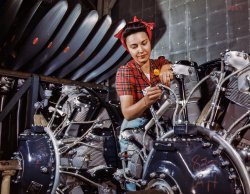
- Mouat Mine, Montana: 1942
- ... in Stillwater County." 4x5 Kodachrome transparency by Alfred Palmer for the Office of War Information. Library of Congress. View full ... Posted by Dave - 08/05/2012 - 6:38pm -
![Mouat Mine, Montana: 1942 August 1942. Stillwater County, Montana. "Development at the site of the mill for the Mouat Chromite mine. Mouat was recently constructed at the foot of one of the higher peaks in Stillwater County." 4x5 Kodachrome transparency by Alfred Palmer for the Office of War Information. Library of Congress. View full size.
Still there, still functioningNote text and picture at lower left, here:
http://www.stillwaterpalladium.com/stillwater2.html
Mouat Mine TodayIt looks like the buildings gave way to a holding pond over the years.
[Thanks thxdave for these great photos. Click to enlarge. - Dave]
Direct link?Dave, do you know if there's a way to create a direct link to the Google Earth "view" that you create on your own screen (elevation, angle, etc.) so people could go directly to the image?
[Hmm. Not that I can see. - Dave]
(The Gallery, Kodachromes, Alfred Palmer, Mining)](https://www.shorpy.com/files/images/1a35031u.thumbnail.jpg)
- Life in Wartime: 1942
- ... George Woolslayer." Medium format negative negative by Alfred Palmer for the OWI. View full size.
French Vineyard? I never thought ... Posted by Dave - 09/11/2011 - 11:34am -
![Life in Wartime: 1942 Pittsburgh, August 1942. "The comforts of home looked pretty good to Navy Radioman John Marshall Evans and Sergeant French L. Vineyard, who spent Sunday with the family of their poster colleague George Woolslayer." Medium format negative negative by Alfred Palmer for the OWI. View full size.
French Vineyard?I never thought I'd see a name to top Olive Groves (heard below), but that might just be it.
My GrandparentsGoogled my last name and was absolutely delighted to see my father's parents. I never knew this photo existed. For reference sake their names were Ethel Householder Woolslayer and George Anthony Woolslayer Sr.
[There are 48 more Woolslayer photos in the Library of Congress archive. And a couple more here on Shorpy. - Dave]
(The Gallery, Alfred Palmer, Pittsburgh, WW2)](https://www.shorpy.com/files/images/8e11122u_1.thumbnail.jpg)
- How to Make a Mustang: 1942
- ... fighter planes." 4x5 inch Kodachrome transparency by Alfred Palmer for the Office of War Information. View full size.
Horrific ... Ruffalo for a second.
(The Gallery, Kodachromes, Alfred Palmer, Aviation, WW2) ... Posted by Dave - 07/22/2012 - 12:48pm -
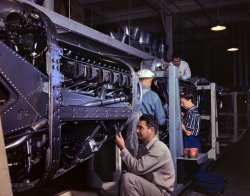
- 1,200 Horses: 1942
- ... View full size. 4x5 Kodachrome transparency by Alfred Palmer for the Office of War Information.
blue sky Yep. Those of us old ... Posted by Dave - 08/30/2012 - 3:27pm -
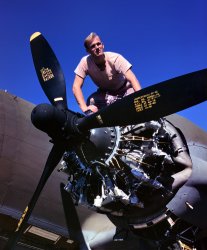
- Aim High: 1942
- ... gun and four machine guns." 4x5 Kodachrome transparency by Alfred Palmer, OWI. View full size.
Rainbow Notion Thanks to Shorpy and the ... Posted by Dave - 08/13/2012 - 5:03pm -
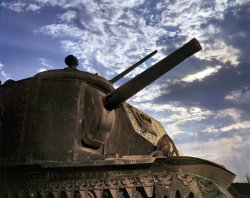
- Annette, Aluminum and You: 1942
- ... View full size. 4x5 Kodachrome transparency by Alfred Palmer for the Office of War Information.
Hurry Up! To me, that face ... Posted by Dave - 07/17/2012 - 10:12pm -
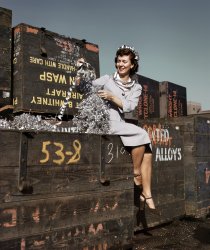
- The Girl in the Bubble: 1942
- ... B-17. View full size. 4x5 Kodachrome transparency by Alfred Palmer.
Day off? I wonder about the posed nature of this photo. True, ... Posted by Dave - 07/17/2012 - 10:04pm -
![The Girl in the Bubble: 1942 Bombardier nose section of a B-17F Navy bomber at the Douglas Aircraft plant in Long Beach, Calif. October 1942. The B-17F "Flying Fortress" is a later model of the B-17. View full size. 4x5 Kodachrome transparency by Alfred Palmer.
Day off?I wonder about the posed nature of this photo. True, women of the past rarely went out of the house unless they were well-coiffed, but wearing of jewelry in the factory was VERY discouraged. A dainty gold watch like hers could easily get caught in a machine or tool and cause injury (possibly what happened to her bandaged finger?).
No doubt this was a posed affair. Knowing the lighting requirements of Kodachrome, there's no way this was a quick "hey you! Lemme grab a snap!". I just wonder how Palmer went about choosing his subjects.
[The large-format OWI Kodachromes taken indoors at assembly plants do not, as a general rule, purport to be candid documentary photography; most were carefully composed and lighted, and taken for a specific purpose. As we have pointed out before, that purpose was often to serve as studies for the artwork used in posters for recruitment, bond drives, safety campaigns, etc. Example below. As far as "jewelry" goes, there's nothing especially remarkable about a 1940s assembly worker wearing a wristwatch. - Dave]
(The Gallery, Kodachromes, Alfred Palmer, Aviation, WW2)](https://www.shorpy.com/files/images/1a35360u_0.thumbnail.jpg)
- Mustang by the Tail: 1942
- ... View full size. 4x5 Kodachrome transparency by Alfred Palmer.
I didn't suppose that color I didn't suppose that color ... Posted by Dave - 07/21/2012 - 10:34pm -
![Mustang by the Tail: 1942 October 1942. A painter cleans the tail section of a P-51 Mustang fighter prior to spraying with olive-drab camouflage. North American Aviation plant, Inglewood, California. View full size. 4x5 Kodachrome transparency by Alfred Palmer.
I didn't suppose that colorI didn't suppose that color photography looked that good these days
It must be a P-51B......judging by the incline on the spine.
Fate of the B-25sThe B-25 in the left background, tail #113178 (or 41-13178) crashed and burned at March Field in Southern California on June 30, 1943. The one on the right, #113180 (or 41-13180), was part of the 340th bomb group, 57th Bombardment Wing, Twelfth Air Force operating in Italy when it was shot down by antiaircraft fire on April 28, 1944. Three crew members, including the pilot were killed; the other four made it back to the base.
This is not THE photoThis is not THE photo taken at 1942, it's probably a reprint of the original negative.
[This is the original transparency. It is not a print. And Kodachromes don't have negatives. - Dave]
(The Gallery, Kodachromes, Alfred Palmer, Aviation, WW2)](https://www.shorpy.com/files/images/1a35303u.thumbnail.jpg)
- Shove It: 1942
- ... of pressure caused by the exploding charge." Photo by Alfred Palmer, Office of War Information. View full size.
Being a pedantic ... Posted by Dave - 12/06/2013 - 7:54pm -
![Shove It: 1942 March 1942. Virginia Beach, Va. "Fort Story coast defense. A tough job for soldiers is shoving the breech block of the giant howitzer into place. The screw threads help the block to withstand millions of foot-pounds of pressure caused by the exploding charge." Photo by Alfred Palmer, Office of War Information. View full size.
Being a pedantic engineer.The term would be "pounds per square inch" of pressure. "Foot-pounds" is a unit of torque, not pressure.
[Foot-pound can also be a unit of energy. - Dave]
Doughboy helmetsRather than the pots that soldiers cooked in from WW2 until the advent of Kevlar in the late '80s, these guys appear to be wearing leftovers from the previous war.
Keep Strapped, Boys!Many a soldier's neck was broken from exploding ordnance within their proximity during WWI, thanks to the chin strap. No wonder many doughboys refused to strap themselves in.
Where?Is it just me, or does it have the look of being shoot in a studio or on a sound stage?
[It resembles that look because Palmer aimed supplementary flash from the right to illuminate their faces, which otherwise would have been in shadow. -tterrace]
All dressed up and nowhere to goExcept for the defense of Corregidor in 1942, a few engagements during the Civil War, and some salient actions during the War of 1812, the US Army's seacoast artillery never fired a shot in anger. Nevertheless, that arm was responsible for many innovations, particularly in fire direction techniques and gun design, that paid significant dividends when applied by the field artillery in both world wars, Korea, Vietnam, and the Gulf.
As for the WW I-style helmets, they were retained in low-priority units (such as Stateside coast artillery batteries) well after we entered WW II because priority for the new "steel pot" helmet naturally went to units deployed or deploying into harm's way. Army and Marine units that left the States after Pearl Harbor did so with the new helmet, of course, but those troops fighting in the Philippines from December 1941 to April 1942 had to be content with the Doughboy's "tin hat," designed primarily to protect against overhead artillery bursts and virtually useless against anything else.
Into the Breech!Here's what the view in the other direction looks like.
Some of these 16" guns (this is a Navy model) were used for industrial purposes for super-high pressure powdered metal sintering.
This particular one is still in use today!
Doughboy Helmets part deuxMy father was drafted into the Army (7th Cavalry, no less) in mid-1940 and they were issued uniforms straight from WWI vintage complete with "salad bowl" helmets. While in the cavalry they wore wide brim "soft" hats instead of helmets. When the unit was converted to armor in 1944 they became an amphibious tank battalion and then wore standard tankers helmets.
From a different angleThese soldiers are man-handling the breechblock of a 16-inch caliber howitzer, a massive weapon that fired a shell weighing over a ton.
Here's a view of a similar breechblock on a 16-inch gun in the defenses of San Francisco that illustrates the scale of these artillery pieces. (The highly burnished steel shows the care that soldiers lavished on these huge -- and expensive -- weapons.)
M1917A1 HelmetLectrogeek, the helmets worn in the photo are the Model 1917A1--the shell is the standard Model 1917 of World War I vintage, but with an improved liner and chin strap assembly. The modification was authorized in 1936 and the modified helmets began to be produced in 1940.
The M1 helmet ["steel pot"] was adopted in the summer of 1941, but due to a delay in tooling up to produce the new helmet, the M1917A1's continued to be made through the end of 1941 and were widely used throughout 1942 until the supply of M1 helmets caught up with the demand. The older helmet was declared obsolete later that year and the M1 helmet would go on to serve through the mid 1980s.
Coastal ArtilleryMany Coastal Artillery regiments were converted to anti-aircraft units around this time. The 200th Coastal Artillery Regiment was a New Mexico National Guard anti-aircraft coastal artillery regiment, converted from a cavalry regiment in 1940. They were sent to the Philippines, arriving in November of 1941. A great number of them died in Japanese captivity
Finally a picture from here…I live at the beach, just blocks from Fort Story. It is a very small base and my friends and i would hang out there and skateboard down these hilly road that they built on the sand dunes. That was in the early 80's, but it is still the same now. We would sneak through the woods and "smoke" back there and find old bomb shells just laying the sand. 4ft long at least. They have a bunch of underground bunkers with doors that appear to go into a sand hill… Very odd looking with rusted old locks on the doors. There was a strip club on the base that we could also sneak into and drink at 16. I was never in the service, nor were my friends, but we certainly had a great time on that base. No one was ever around…? We never met a single military person. Still i have only met a few, and lived in Va. Beach for 44 years. Good Times. Thanks Shorpy.
BreachThis type of breach lock is known as buttress thread.
(The Gallery, Alfred Palmer, WW2)](https://www.shorpy.com/files/images/SHORPY_8e11187u.thumbnail.jpg)
- Head Spotters: 1942
- ... Aluminum Industries Inc." 4x5 nitrate negative by Alfred Palmer for the Office of War Information. View full size.
Offstage ... Posted by Dave - 07/29/2012 - 2:40pm -
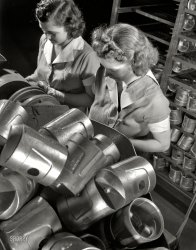
- Redacted: 1942
- ... fuselage have been scratched off the negative. Photo by Alfred Palmer for the Office of War Information. View full size.
Northern ... Posted by Dave - 11/05/2021 - 4:01pm -
![Redacted: 1942 October 1942. "A long line of C-47 transport planes awaits the installation of wings at the Long Beach, California, plant of Douglas Aircraft Company. The versatile C-47 performs many important tasks for the Army. It ferries men and cargo across oceans and mountains, tows gliders and brings paratroopers and their equipment to scenes of action." Note how, as on the photo in the previous post, certain markings on the fuselage have been scratched off the negative. Photo by Alfred Palmer for the Office of War Information. View full size.
Northern HemisphereThey work clockwise around the room, going by tail numbers.
Remarkable numbersIn another part of the plant they produced B-17s under license from Boeing.
Between the two types they produced about one aircraft per hour during the War.
Namesake of the clothespinOn film sets and in photo studios it is cool to call clothespins C-47s, for their versatility.
Re: WingsIt's always amazed (or baffled) me, how the wings, carrying maybe 80% of the plane's weight, can attach to those root sections with bolts and/or rivets, and not just rip off!
Tail numbersThe tail number is a partial serial number. Tail number 118625 is serial number 41-18625, the 41 being the fiscal year the contract was let. With the help of the interweb place it is possible to trace each of these aircraft. Example: 118627 (41-18627) was transferred to the USAAF on Oct 26, 1942, then to Cairo on Feb 17, 1943, and then to the 8th Air Force in England on Feb 27, 1944. It was lost (missing) on Oct 24, 1944. www.joebaugher.com is the go-to source for aircraft history and information.
Censored ShipsI love the how the original negative had information on the nose of the aircraft redacted for OPSEC purposes. Fantastic image!
[Censor missed the placard at the back of the plane, which seems to be the same as the one at the front. - Dave]
Gooney Bird StatusAccording to an archive of serial numbers, 18629 survived and is awaiting restoration.
D-Day Ship#8632 was a D-Day ship and flew members of the 508 PIR.
(The Gallery, Alfred Palmer, Aviation, Factories, WW2)](https://www.shorpy.com/files/images/SHORPY-8b05585u.thumbnail.jpg)
- Innerwing Inspectors: 1942
- ... View full size. 4x5 Kodachrome transparency by Alfred Palmer.
Love the style I wonder if they dressed that nice all the time ... Posted by Dave - 07/22/2012 - 12:46pm -
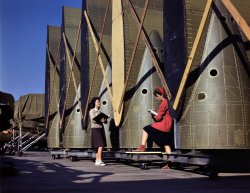
- Levers of Power: 1942
- ... Authority's Douglas Dam. 4x5 Kodachrome transparency by Alfred Palmer for the OWI. View full size.
Overwhelmed! The amount of ... Posted by Dave - 08/01/2012 - 1:34pm -
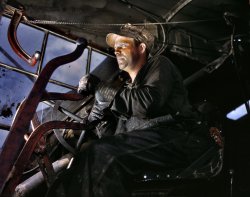
- Big Pete: 1942
- ... View full size. 4x5 Kodachrome transparency by Alfred Palmer.
Wow! Imagine the amount of information contained in this image ... Posted by Dave - 08/05/2012 - 10:53am -
![Big Pete: 1942 June 1942. "Big Pete" Ramagos, a rigger at work on the TVA's Douglas Dam in Tennessee. View full size. 4x5 Kodachrome transparency by Alfred Palmer.
Wow!Imagine the amount of information contained in this image compared to DSLR.
How?!I can't stop looking at this. I am terrified and in awe.
Hard Working FellaThis is the face of the men who built this country. Their industry is what made our economy flourish. It is production and not consumerism that makes a nation great. My hat is off to Big Pete and everyone like him that worked, and worked hard; for themselves, their families, and their country.
What's the Story Behind the Picture?I would really love to know more about Big Pete and what happened to him beyond the taking of this photo. The most amazing thing about Kodachrome is how well it makes yesteryear seem like yesterday, especially the medium and large format varieties. But the saddest thing is that the people who look so alive in them have often long since passed away. You can almost sense how much Big Pete is concentrating here, and how tiring the work must have been. I too am in awe of this picture. If anyone can shed any light on Pete I'd be very grateful.
This is my Great-GrandfatherI am so proud that this is a picture of my great-grandfather!
[What can you tell us about him? - Dave]
(The Gallery, Kodachromes, Alfred Palmer, WW2)](https://www.shorpy.com/files/images/1a35243u1.thumbnail.jpg)
- Metalhead: 1942
- ... View full size. 4x5 Kodachrome transparency by Alfred Palmer for the Office of War Information.
Slice and Dice Those curlicues ... Posted by Dave - 08/30/2012 - 3:31pm -
![Metalhead: 1942 October 1942. "Office employee Annette del Sur publicizing salvage campaign in yard of Douglas Aircraft Company, Long Beach, California. The earrings and hair ornaments are fashioned from aluminum turnings." View full size. 4x5 Kodachrome transparency by Alfred Palmer for the Office of War Information.
Slice and DiceThose curlicues look sharp enough to be dangerous.
Metal shavings are sharp!Hopefully, she had those shavings sanded down a little. When I was young and stupid, I made a copper "ring" with a pipe-cutter and didn't realize the indent it made on the inside of the ring had an edge!
Picture # 2I am sure I saw this same picture published on these pages on an earlier date.
[This is our third photo of Annette so far. But they're all different. - Dave]
(The Gallery, Kodachromes, Alfred Palmer, Aviation, WW2)](https://www.shorpy.com/files/images/1a35349u.thumbnail.jpg)
- Akron: 1941
- ... View full size. 4x5 Kodachrome transparency by Alfred Palmer.
Blimp Bay We still have one of these at Moffett Field in San ... Posted by Dave - 08/03/2012 - 3:02pm -
